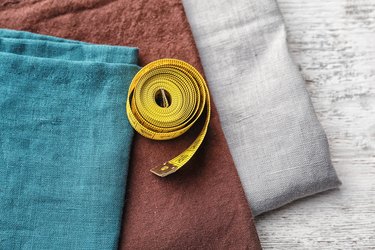
Woven fabrics such as cotton are likely to fray on the edges if left untreated if they're not hemmed. The most common way to prevent fraying is to sew the edge; however, if you do not own a sewing machine, that won't work. In that case, there are several alternative methods to keep fabric from fraying without sewing.
Method One: Pinking Shears
Video of the Day
Pinking shears are similar to scissors except that they have a serrated edge that creates a zigzag cut on the edge of the fabric. Pinking produces a clean edge, and it's very easy to do.
Video of the Day
To keep fabric from fraying using pinking shears, simply trim the edges of the fabric with the shears. Pinking shears work best on fabric that is crisp and smooth such as taffeta.
Tip
Pinking shears tend to be heavy, making it difficult to shear long lengths of fabric. As an alternative, look for a rotary cutter that has a pinking blade.
While pinking shears will reduce fraying, they won't prevent it completely. You may find that a pinked edge will begin to fray after several cycles through the washing machine.
Method Two: Fabric Sealants
Fabric sealants are clear plastic liquids in a tube that seal the fabric edge and stop fraying without sewing. Fabric sealants, which are made by several different companies, are available in craft stores.
To apply fabric sealants, trim any loose threads from the edge of the fabric. Squeeze the tube to apply a thin coat to the edges of the fabric. The sealant will dry clear.
Tip
If the fabric sealant appears cloudy or white in the tube, test it on scrap fabric before applying it. Cloudy fabric sealant could cause discoloration when applied.
Fabric sealants dry clear and won't stiffen the fabric. The sealants are designed to last through multiple washes, but you may find that the sealant becomes weaker with each wash.
If you need to remove the fabric sealant for any reason, you may do so using a cotton swab dipped in rubbing alcohol.
Method Three: Fusible Interfacing
Fusible interfacing, available in most craft stores, comes in many different weights. Before applying the interfacing, you need to choose a weight that matches the weight of your fabric. For example, if your fabric is a heavy denim, then choose a heavy interfacing; if your fabric is a light cotton, then choose a light fusible interfacing.
To apply the interfacing to the fabric edge, first cut a piece of interfacing that is 1/2 inch wide and the same length as the untreated fabric edge. Place the interfacing with the webbed-side down onto the fabric's wrong-side edge, lining up the edges of the fabric and the interfacing. Using an iron set to high heat, place the iron on top of the interfacing and hold it for 2 to 3 seconds. Move the iron, lifting rather than sliding, until you have applied heat to the entire piece of interfacing. Always follow the manufacturer's instructions to ensure you are using the right method for the brand you purchase.
While interfacing provides a sturdy edge, it also makes the edge stiff, which does not allow for much movement. Interfacing is also more visible than treatments like fabric sealants, so it is not suitable for all fabric edges. You will not be able to use interfacing on fabric that cannot tolerate the heat of an iron, such as silk.